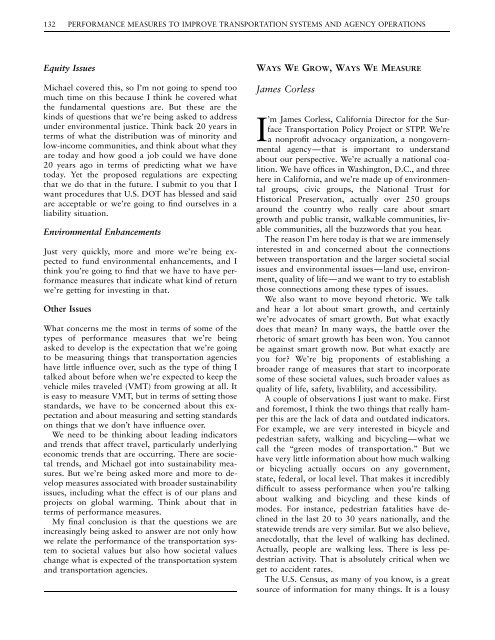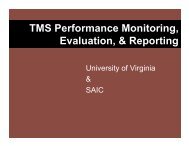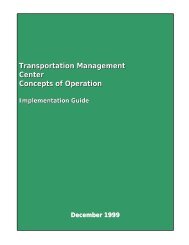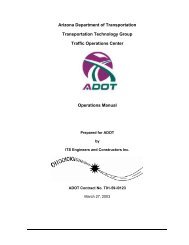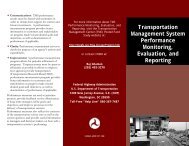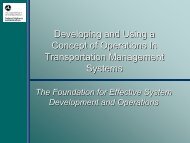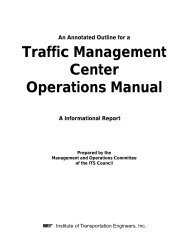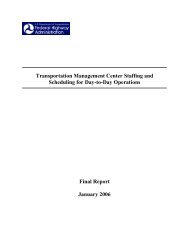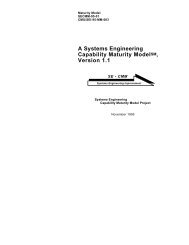132 PERFORMANCE MEASURES TO IMPROVE TRANSPORTATION SYSTEMS AND AGENCY OPERATIONSEquity IssuesMichael covered this, so I’m not going to spend toomuch time on this because I think he covered whatthe fundamental questions are. But these are thekinds of questions that we’re being asked to addressunder environmental justice. Think back 20 years interms of what the distribution was of minority andlow-income communities, and think about what theyare today and how good a job could we have done20 years ago in terms of predicting what we havetoday. Yet the proposed regulations are expectingthat we do that in the future. I submit to you that Iwant procedures that U.S. DOT has blessed and saidare acceptable or we’re going to find ourselves in aliability situation.Environmental EnhancementsJust very quickly, more and more we’re being expectedto fund environmental enhancements, and Ithink you’re going to find that we have to have performancemeasures that indicate what kind of returnwe’re getting for investing in that.Other IssuesWhat concerns me the most in terms of some of thetypes of performance measures that we’re beingasked to develop is the expectation that we’re goingto be measuring things that transportation agencieshave little influence over, such as the type of thing Italked about before when we’re expected to keep thevehicle miles traveled (VMT) from growing at all. Itis easy to measure VMT, but in terms of setting thosestandards, we have to be concerned about this expectationand about measuring and setting standardson things that we don’t have influence over.We need to be thinking about leading indicatorsand trends that affect travel, particularly underlyingeconomic trends that are occurring. There are societaltrends, and Michael got into sustainability measures.But we’re being asked more and more to developmeasures associated with broader sustainabilityissues, including what the effect is of our plans andprojects on global warming. Think about that interms of performance measures.My final conclusion is that the questions we areincreasingly being asked to answer are not only howwe relate the performance of the transportation systemto societal values but also how societal valueschange what is expected of the transportation systemand transportation agencies.WAYS WE GROW, WAYS WE MEASUREJames CorlessI’m James Corless, California Director for the Surface<strong>Transportation</strong> Policy Project or STPP. We’rea nonprofit advocacy organization, a nongovernmentalagency—that is important to understandabout our perspective. We’re actually a national coalition.We have offices in Washington, D.C., and threehere in California, and we’re made up of environmentalgroups, civic groups, the National Trust forHistorical Preservation, actually over 250 groupsaround the country who really care about smartgrowth and public transit, walkable communities, livablecommunities, all the buzzwords that you hear.The reason I’m here today is that we are immenselyinterested in and concerned about the connectionsbetween transportation and the larger societal socialissues and environmental issues—land use, environment,quality of life—and we want to try to establishthose connections among these types of issues.We also want to move beyond rhetoric. We talkand hear a lot about smart growth, and certainlywe’re advocates of smart growth. But what exactlydoes that mean? In many ways, the battle over therhetoric of smart growth has been won. You cannotbe against smart growth now. But what exactly areyou for? We’re big proponents of establishing abroader range of measures that start to incorporatesome of these societal values, such broader values asquality of life, safety, livablility, and accessibility.A couple of observations I just want to make. Firstand foremost, I think the two things that really hamperthis are the lack of data and outdated indicators.For example, we are very interested in bicycle andpedestrian safety, walking and bicycling—what wecall the ‘‘green modes of transportation.’’ But wehave very little information about how much walkingor bicycling actually occurs on any government,state, federal, or local level. That makes it incrediblydifficult to assess performance when you’re talkingabout walking and bicycling and these kinds ofmodes. For instance, pedestrian fatalities have declinedin the last 20 to 30 years nationally, and thestatewide trends are very similar. But we also believe,anecdotally, that the level of walking has declined.Actually, people are walking less. There is less pedestrianactivity. That is absolutely critical when weget to accident rates.The U.S. Census, as many of you know, is a greatsource of information for many things. It is a lousy
PANEL DISCUSSION: CONNECTING SYSTEM PERFORMANCE MEASURES TO BROADER GOALS 133source of information for transportation. Friends ofmine on the East Coast tell me that for counting bicycling—andlet’s not even forget this is journey-toworktrips, obviously a very small share of all trips—the census in 1990 happened to pick a week inMarch on the East Coast where we had a freak snowstorm.Few people were out bicycling or walking. Yetthose were the data collected that then went into thenext 10 years of planning. You look at those modeshares, and they seem to be very small.I want to talk about three things in terms of performancemeasures, three areas that we think are important,especially here in California: capacity, modeshare, and safety. This, I think, relates to what Mikewas talking about in terms of outputs versus outcomes.We couldn’t be more concerned about the useof outputs and the inherent implications that somehowthese outputs are really what we’re after.CapacityIn terms of capacity, in California we have been engagedin a debate for many years, but especially inthe last year, about additional transportation investment.We have heard over and over again that in thelast 10 years in California, our state highway systemhas only grown by 1 percent in terms of lane miles.Population has grown by 13 percent; VMT hasgrown by <strong>26</strong> percent. So things haven’t kept up withone another. Unfortunately, the state highway systemis the state-owned road system. It actually has verylittle to do with the actual functional capacity of theentire system. Our state highways also double as littlelocal main streets that run through small towns.Highway 1 is a state highway. That actually is a verylousy performance measure for how much lane mileageyou have out there. What’s much more reliable,of course, is freeways, expressways, and principal arterialstreets. If we counted those, didn’t look at thestate level, and focused on the metropolitan area, wewould actually see that road capacity has increased.It has actually increased on par with population. Butwhat we haven’t been able to keep up with is VMT.VMT is off the charts, as it is in most places. Wethink that’s a really critical distinction to make. Atthe state level in California, we get into all kinds ofproblems, trying to look at such a macro level onthese numbers.Mode ShareMode share, which is statewide in California, isabout 3 to 4 percent. This sounds pretty lousy. Yetwe have tremendous transit ridership, largely in LosAngeles and the San Francisco Bay area. We haveseven times as many transit riders in California ascommercial airline passengers out of all of our majorairports. Yet that never really gets discussed. If youfocus in on the regional level, even at the corridorlevel, the transit ridership going into downtown SanFrancisco through the I-80 corridor is 38 percent ofall trips. In Los Angeles including downtown, it’s 30percent; in San Diego, it’s 18 percent. So if we focuson the corridor level, we see that these are muchmore reliable indicators.SafetyIn terms of accident rates, especially for bicyclists andpedestrians, be very cautious of using just pure fatalityand injury rates per population. If we do thatin San Francisco, we have the highest fatality andinjury rate of any county or city in California. Thatis because we also have the highest level of walking—the highest amount of pedestrian activity—whichwe think is a very good thing and in urban areas,something we want to encourage. However, just theaccident rates alone would make you think that SanFrancisco is a very unsafe place to walk. The fact ofthe matter is, there are a lot of places that are far lesssafe, but we don’t have numbers for levels of exposureor levels of activity or mileage walked, somethingthat is critical in terms of looking at accidentrates for pedestrians and bicyclists.Sheldon mentioned that we passed Assembly Bill2140 in California last year. This is a first step toestablish some common performance measures. Icouldn’t agree more with the notion that all theregions in California are very different. We do, however,think there is some core measures that need tostart to be counted that actually do apply to regionto region. These are basically VMT per capita, congestion,road condition, mode share, safety and accidentrates, access to transit, and access to jobs.Those are the measures embedded in State Law AB2140. That law is permissive right now. You don’thave to do anything. But it’s a first step. It’s not instate code in terms of establishing performance measuresat the MPO, the regional level, in California.So in conclusion, it’s critical what we measure. Theenvironmental community is behind quantifying a lotof the things that we care about. Yet we also worryabout the details, and we need to measure manymore things than we’re currently measuring. Thatpoint was made earlier, and I couldn’t agree more.We’ve got to think outside the box, and we have toget beyond some of these traditional quantificationmethods. We also need to apply the measurements
- Page 5 and 6:
National Academy of SciencesNationa
- Page 7 and 8:
Workshop Summary ..................
- Page 9:
General OverviewIntroductionExecuti
- Page 12 and 13:
4 PERFORMANCE MEASURES TO IMPROVE T
- Page 14 and 15:
6 PERFORMANCE MEASURES TO IMPROVE T
- Page 18 and 19:
10 PERFORMANCE MEASURES TO IMPROVE
- Page 20 and 21:
12 PERFORMANCE MEASURES TO IMPROVE
- Page 23:
Linking Performance Measures withDe
- Page 26 and 27:
18 PERFORMANCE MEASURES TO IMPROVE
- Page 28 and 29:
20 PERFORMANCE MEASURES TO IMPROVE
- Page 30 and 31:
22 PERFORMANCE MEASURES TO IMPROVE
- Page 32 and 33:
24 PERFORMANCE MEASURES TO IMPROVE
- Page 34 and 35:
26 PERFORMANCE MEASURES TO IMPROVE
- Page 36 and 37:
28 PERFORMANCE MEASURES TO IMPROVE
- Page 38 and 39:
30 PERFORMANCE MEASURES TO IMPROVE
- Page 40 and 41:
32 PERFORMANCE MEASURES TO IMPROVE
- Page 42 and 43:
Panel DiscussionJohn Poorman, Capit
- Page 44 and 45:
36 PERFORMANCE MEASURES TO IMPROVE
- Page 46 and 47:
38 PERFORMANCE MEASURES TO IMPROVE
- Page 48 and 49:
Workshop SummaryJohn Basilica, Loui
- Page 50 and 51:
42 PERFORMANCE MEASURES TO IMPROVE
- Page 52 and 53:
44 PERFORMANCE MEASURES TO IMPROVE
- Page 55 and 56:
RESOURCE PAPERImplementing Performa
- Page 57 and 58:
IMPLEMENTING PERFORMANCE MEASUREMEN
- Page 59 and 60:
IMPLEMENTING PERFORMANCE MEASUREMEN
- Page 61 and 62:
IMPLEMENTING PERFORMANCE MEASUREMEN
- Page 63 and 64:
IMPLEMENTING PERFORMANCE MEASUREMEN
- Page 65 and 66:
IMPLEMENTING PERFORMANCE MEASUREMEN
- Page 67 and 68:
Panel DiscussionJennifer Finch, Col
- Page 69 and 70:
FIGURE 2Level of measures and align
- Page 71 and 72:
PANEL DISCUSSION: AGENCY IMPLEMENTA
- Page 73 and 74:
PANEL DISCUSSION: AGENCY IMPLEMENTA
- Page 75 and 76:
PANEL DISCUSSION: AGENCY IMPLEMENTA
- Page 77 and 78:
PANEL DISCUSSION: AGENCY IMPLEMENTA
- Page 79 and 80:
WORKSHOP SUMMARY: AGENCY IMPLEMENTA
- Page 81:
Selecting Measures, Data Needs, and
- Page 84 and 85:
76 PERFORMANCE MEASURES TO IMPROVE
- Page 86 and 87:
78 PERFORMANCE MEASURES TO IMPROVE
- Page 88 and 89:
80 PERFORMANCE MEASURES TO IMPROVE
- Page 90 and 91: 82 PERFORMANCE MEASURES TO IMPROVE
- Page 92 and 93: 84 PERFORMANCE MEASURES TO IMPROVE
- Page 94 and 95: 86 PERFORMANCE MEASURES TO IMPROVE
- Page 96 and 97: Panel Discussion, Part 1Anita Vande
- Page 98 and 99: 90 PERFORMANCE MEASURES TO IMPROVE
- Page 100 and 101: 92 PERFORMANCE MEASURES TO IMPROVE
- Page 102 and 103: Panel Discussion, Part 2Douglas Zim
- Page 104 and 105: FIGURE 11 Example data
- Page 106 and 107: 98 PERFORMANCE MEASURES TO IMPROVE
- Page 108 and 109: Workshop SummaryBrenda Berg, Trans
- Page 110 and 111: 102 PERFORMANCE MEASURES TO IMPROVE
- Page 113 and 114: RESOURCE PAPERMeasuring That Which
- Page 115 and 116: MEASURING THAT WHICH CANNOT BE MEAS
- Page 117 and 118: TABLE 1Sustainability MeasuresNewma
- Page 119 and 120: MEASURING THAT WHICH CANNOT BE MEAS
- Page 121 and 122: MEASURING THAT WHICH CANNOT BE MEAS
- Page 123 and 124: MEASURING THAT WHICH CANNOT BE MEAS
- Page 125 and 126: MEASURING THAT WHICH CANNOT BE MEAS
- Page 127 and 128: MEASURING THAT WHICH CANNOT BE MEAS
- Page 129 and 130: MEASURING THAT WHICH CANNOT BE MEAS
- Page 131 and 132: MEASURING THAT WHICH CANNOT BE MEAS
- Page 133 and 134: MEASURING THAT WHICH CANNOT BE MEAS
- Page 135 and 136: PANEL DISCUSSION: CONNECTING SYSTEM
- Page 137 and 138: PANEL DISCUSSION: CONNECTING SYSTEM
- Page 139: PANEL DISCUSSION: CONNECTING SYSTEM
- Page 143 and 144: Workshop SummaryScott Bassett, Oreg
- Page 145: Freight Performance MeasuresCurrent
- Page 148 and 149: 140 PERFORMANCE MEASURES TO IMPROVE
- Page 150 and 151: 142 PERFORMANCE MEASURES TO IMPROVE
- Page 152 and 153: 144 PERFORMANCE MEASURES TO IMPROVE
- Page 154 and 155: 146 PERFORMANCE MEASURES TO IMPROVE
- Page 156 and 157: 148 PERFORMANCE MEASURES TO IMPROVE
- Page 158 and 159: 150 PERFORMANCE MEASURES TO IMPROVE
- Page 160 and 161: 152 PERFORMANCE MEASURES TO IMPROVE
- Page 163 and 164: APPENDIX ASummaries of 20 Poster Se
- Page 165 and 166: SUMMARIES OF 20 POSTER SESSIONS 157
- Page 167 and 168: TABLE 1(continued) WSDOT Outcomes,
- Page 169 and 170: SUMMARIES OF 20 POSTER SESSIONS 161
- Page 171 and 172: SUMMARIES OF 20 POSTER SESSIONS 163
- Page 173 and 174: SUMMARIES OF 20 POSTER SESSIONS 165
- Page 175 and 176: SUMMARIES OF 20 POSTER SESSIONS 167
- Page 177 and 178: FIGURE 2 Sacramento Regional Transi
- Page 179 and 180: FIGURE 3Goal evaluation table: Chit
- Page 181 and 182: SUMMARIES OF 20 POSTER SESSIONS 173
- Page 183 and 184: SUMMARIES OF 20 POSTER SESSIONS 175
- Page 185 and 186: SUMMARIES OF 20 POSTER SESSIONS 177
- Page 187 and 188: TABLE 6Mobility Performance Measure
- Page 189 and 190: SUMMARIES OF 20 POSTER SESSIONS 181
- Page 191 and 192:
SUMMARIES OF 20 POSTER SESSIONS 183
- Page 193 and 194:
SUMMARIES OF 20 POSTER SESSIONS 185
- Page 195 and 196:
FIGURE 13 MPAH lane-miles by roadwa
- Page 197 and 198:
SUMMARIES OF 20 POSTER SESSIONS 189
- Page 199 and 200:
SUMMARIES OF 20 POSTER SESSIONS 191
- Page 201 and 202:
SUMMARIES OF 20 POSTER SESSIONS 193
- Page 203 and 204:
SUMMARIES OF 20 POSTER SESSIONS 195
- Page 205 and 206:
SUMMARIES OF 20 POSTER SESSIONS 197
- Page 207 and 208:
SUMMARY OF PEER EXCHANGE ON DATA FO
- Page 209 and 210:
SUMMARY OF PEER EXCHANGE ON DATA FO
- Page 211 and 212:
SUMMARY OF PEER EXCHANGE ON DATA FO
- Page 213 and 214:
SUMMARY OF PEER EXCHANGE ON DATA FO
- Page 215 and 216:
SUMMARY OF PEER EXCHANGE ON DATA FO
- Page 217 and 218:
SUMMARY OF PEER EXCHANGE ON DATA FO
- Page 219 and 220:
SUMMARY OF PEER EXCHANGE ON DATA FO
- Page 221 and 222:
SUMMARY OF PEER EXCHANGE ON DATA FO
- Page 223 and 224:
APPENDIX C: RESEARCH STATEMENTS DEV
- Page 225 and 226:
LIST OF PARTICIPANTS 217University,
- Page 227:
LIST OF PARTICIPANTS 219Darwin Stua


